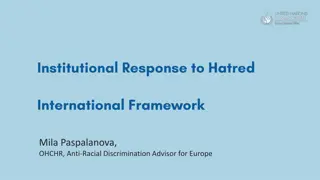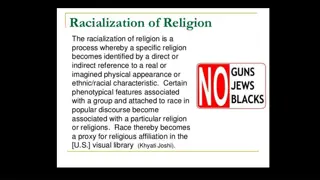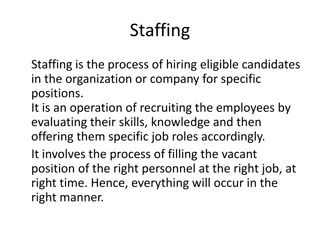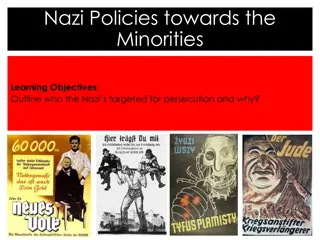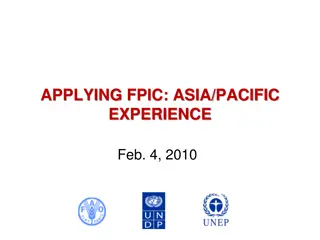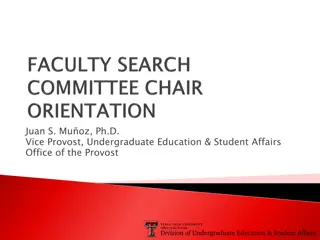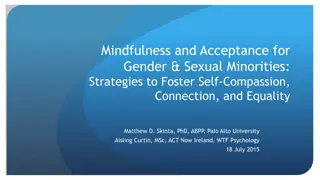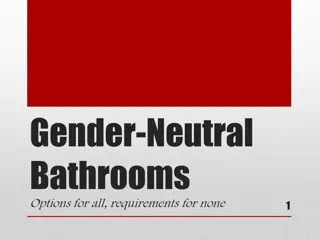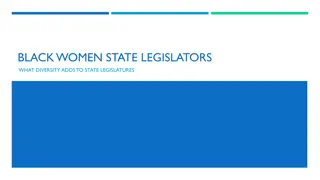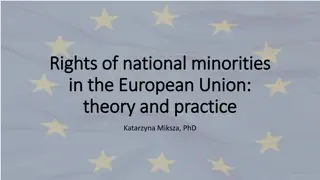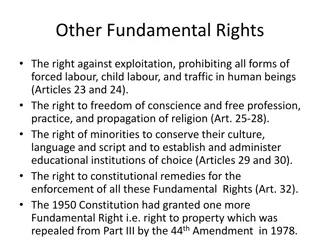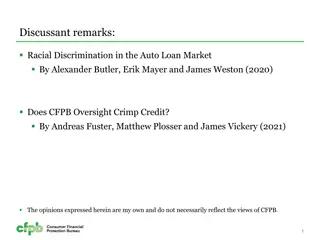Welfare, Women, and Race: A Historical Perspective and Current Policies
Explore the history of welfare policies and their impact on women and racial minorities. From the early 1900s to the present, this article examines the discriminatory practices, pathologizing poverty, and policy changes that have affected marginalized communities. Consider the role of implicit bias,
4 views • 16 slides
Understanding Supplier Diversity: Grange Enterprise Program
Supplier Diversity is a proactive program at Grange Enterprise that encourages minority-owned businesses to participate in sourcing. This initiative, managed by Enterprise Strategic Sourcing, aims to promote diverse suppliers such as Black, Hispanic, women, veterans, LGBT, and non-Caucasian male-own
1 views • 6 slides
Status of Family Laws in India: Hindu vs. Religious Minorities
The family and personal status laws in India vary between Hindu law and those pertaining to religious minorities. While Hindu law has seen extensive reforms, discriminatory provisions still exist. In contrast, laws governing religious minorities have undergone fewer reforms, leading to greater inequ
2 views • 4 slides
Addressing Health Inequalities and Vaccine Hesitancy in Shirebrook: Findings and Strategies
Shirebrook, a deprived area in Derbyshire, has been grappling with health inequalities and vaccine hesitancy, particularly among certain groups like ethnic minorities and those living in deprivation. Efforts have been made to engage the community, resulting in varying levels of vaccine uptake among
1 views • 14 slides
International Human Rights Treaties and Recommendations for Combatting Racism
Mila Paspalanova, the Anti-Racial Discrimination Advisor for Europe at OHCHR, discusses core treaties related to racial discrimination, international conventions, and efforts to combat discrimination based on religion or belief. The content highlights the importance of ICERD, ICCPR, and other key tr
6 views • 16 slides
Embracing Religious Pluralism for a Harmonious Society
Educate yourself on world religions and religious oppression, empathize with religious minorities, combat generalizations, and promote belief inclusion in all aspects of life for a more just and peaceful world.
0 views • 6 slides
Importance of Diversity in Healthcare Workforce
The importance of recruiting and retaining a diverse workforce in healthcare is highlighted through the benefits it brings, such as improved patient outcomes for diverse populations and enhanced cultural competence. Diversity helps address disparities in healthcare experienced by racial and ethnic m
1 views • 37 slides
Normative Accents in English: RP and GenAm Overview
Normative English accents, Received Pronunciation (RP) and General American (GenAm), serve as reference points for English learners and speakers globally. RP is associated with the British elite and institutions, while GenAm represents a regionless form of American pronunciation. Both accents, spoke
0 views • 22 slides
The Roma Community in Finland: History, Culture, and Challenges
The Roma community in Finland, one of the national minorities, has a rich history dating back to the 1500s. Their culture emphasizes cleanliness, good manners, and respect for the elderly. Despite efforts to preserve their language and culture, discrimination and societal challenges persist, impacti
0 views • 6 slides
Understanding the Importance of Staffing in Organizational Success
Staffing is a critical process in organizations that involves hiring eligible candidates for specific positions, ensuring the right people are in the right roles at the right time. It encompasses manpower planning, recruitment, selection, training, and employee welfare, ultimately contributing to ac
0 views • 20 slides
High Commissioner on National Minorities (HCNM) Mandate and Activities
The High Commissioner on National Minorities (HCNM) was established in 1992 by the OSCE to prevent conflicts related to national minority issues. Through quiet diplomacy and early warning mechanisms, the HCNM works to identify and address ethnic tensions that could threaten peace and stability among
0 views • 8 slides
Nazi Persecution of Minorities: Targets and Rationale
The Nazis targeted various groups for persecution, believing in a racial hierarchy where certain races were deemed inferior. They aimed to eliminate those they considered undesirable, including Gypsies, black people, the mentally disabled, homosexuals, and more. The Nazis' actions were driven by the
7 views • 12 slides
Applying FPIC: Asia Pacific Experience
Vietnam, with its diverse ethnic groups, faces challenges in implementing FPIC (Free, Prior, and Informed Consent). Past policies have influenced the distribution of ethnic minorities and poverty alleviation efforts. The principles of UNDRIP guide the FPIC process, emphasizing community engagement a
3 views • 29 slides
Challenges Faced by First-Generation College Students
First-generation college students encounter various barriers and challenges that affect their educational journey and success rates. These students are more likely to be racial/ethnic minorities, low-income, and have dependent children. Despite attempts to enter college, they graduate at significant
0 views • 11 slides
Recognizing Warning Signs and Vulnerable Groups During the Pandemic
This article sheds light on groups particularly vulnerable to decreased well-being and resilience amid the pandemic, including Black and Ethnic Minorities, individuals living in poverty or facing domestic abuse, LGBTQ+ individuals, those with pre-existing mental health needs, young carers, and more.
0 views • 13 slides
Understanding Structural Causes of Inequities in STEM Hiring for Increased Diversity
This presentation by Kim Shauman from UC Davis delves into the structural influences that impact diversity levels in STEM faculty recruitment. It highlights factors such as the supply of diversity in the pipeline, representation of women and underrepresented minorities among STEM doctoral degree rec
2 views • 20 slides
Student Equity Report: Goals and Initiatives for Inclusive Education
Berkeley City College's Student Equity Report outlines goals to increase access, course completion rates, and basic skill success for diverse student populations. Initiatives include outreach, retention strategies, and supplementary support, focusing on ethnic minorities, students with disabilities,
0 views • 15 slides
University Faculty Search and Affirmative Action Overview
This content discusses the paramount characteristics for conducting faculty searches, including consistency, transparency, and equity. It emphasizes the importance of diversity and underrepresented minorities in the recruitment process, as mandated by Affirmative Action policies. Failure to meet Aff
0 views • 16 slides
Strategies for Self-Compassion and Equality in Gender and Sexual Minorities
This content discusses mindfulness and acceptance strategies to foster self-compassion, connection, and equality for gender and sexual minorities. It emphasizes the importance of understanding personal histories and breaking free from societal stigma to access freedom and peace. The text also touche
0 views • 16 slides
Understanding Hindu Nationalism: From History to Contemporary Realities
Delve into the complexities of Hindu Nationalism through an exploration of its historical roots, contemporary manifestations, and the distinction between Hindutva and Hinduism. Explore key themes, readings, and debates surrounding the rise of Hindu Nationalism in India, shedding light on its implica
0 views • 15 slides
History and Impact of the Ku Klux Klan in the United States
The Ku Klux Klan (KKK) is a notorious secret organization founded in Pulaski, Tennessee, in 1865 by former Confederate army officers. Originally aimed at suppressing the power of blacks and minorities, the KKK evolved over the years with a goal to reestablish white supremacy. The Klan was responsibl
0 views • 5 slides
Revolutionary War and the Birth of Republican Governments in America, 1776-1789
The content discusses key events and figures during the Revolutionary War era, including the challenges faced by Patriots, victories at Saratoga, financial crisis, assistance from France, military strategies, the Treaty of Paris, and the role of women and minorities. It also touches on the influence
0 views • 10 slides
Enhancing Student Engagement and Academic Success in Higher Education
Techniques to aid student engagement and success in academia include active learning, collaboration, and alignment with research on effective learning methods. The presentation also highlights statistics on women and minorities in STEM fields, as well as the challenges faced by minority students in
0 views • 40 slides
Gender-Neutral Bathrooms: Ensuring Safety and Inclusivity
Explore the importance of gender-neutral bathrooms to ensure safety for all, regardless of gender identity. Learn about terms like non-binary, cisgender, FTM/MTF, and intersex, and the impact of bathroom accessibility on student safety and well-being. Discover the role of public policy in promoting
0 views • 37 slides
Importance of Diversity in State Legislatures
Legislatures with higher proportions of women and minorities tend to sponsor and pass legislation that caters to the interests of underrepresented groups. However, the marginalization of women and minority legislators by their white male colleagues can limit their influence in policymaking. Intersec
0 views • 12 slides
Exploring Raciolinguistics in Medical Spanish Education
Delve into the intersection of racism, linguistics, and medical Spanish education to enhance care for linguistic minorities with equity. Understand raciolinguistic perspectives, apply language & race concepts to teaching communication skills, evaluate curricular materials for raciolinguistic hierarc
0 views • 11 slides
Challenges Faced by Roma Language Education in Europe
The European Regional Forum on Education, Language, and the Human Rights of Minorities, led by Policy and Advocacy Officer Roland Ferkovics, addresses systematic and institutional barriers in Roma language education. Issues include deficiencies in state curricula, lack of teaching materials, absence
0 views • 8 slides
Evolution of Affirmative Action Policies in College Admission in China
The historical development of affirmative action policies in college admissions in China is traced from the Republic Era to contemporary times. The policies have evolved from preferential treatment based on certain backgrounds to programs benefiting ethnic minorities and residents in underdeveloped
0 views • 20 slides
Understanding Cultural Diversity in Healthcare
The content explores the significance of cultural diversity in healthcare, emphasizing the increasing diversity of the population in the United States and the importance of cultural competence in nursing. It delves into cultural concepts, transcultural nursing, cultural context of health and caring,
0 views • 13 slides
Rights of National Minorities in the European Union: Theory and Practice
This content delves into the protection and recognition of the rights of national minorities within the European Union. It covers various aspects such as antidiscrimination efforts, the application of non-discrimination principles, the role of Member States, and the EU's policies on minority rights.
1 views • 29 slides
Fundamental Rights and Directive Principles of State Policy in Indian Constitution
The Indian Constitution guarantees Fundamental Rights such as the right against exploitation, freedom of conscience, and the right of minorities. It also includes Directive Principles of State Policy (DPSP) to guide the government in promoting social welfare. Fundamental Rights and DPSP are meant to
0 views • 6 slides
Challenges to Religious Freedom in India: An Overview
India, as the world's largest democracy with a tradition of secularism, faces escalating challenges to religious freedom and civil society. The BJP-led government's Hindu nationalist agenda has led to systematic violations of religious rights, targeting minorities and activists. The tightening grip
0 views • 20 slides
Racial Discrimination in Auto Loan Market: Insights & Impacts
This study explores racial discrimination in the auto loan market, revealing evidence of bias in both loan approval and pricing. Findings suggest minorities experience challenges in obtaining credit and face higher loan pricing without justification. The analysis uncovers disparities in loan approva
0 views • 15 slides
Post-War Issues: Nativism, Red Scare, and Labor Unrest in the 1920s
The 1920s saw a rise in nativism, with Americans feeling threatened by job competition from women and minorities. The era was marked by the Red Scare, fueled by fears of communism spreading globally, leading to the formation of the Ku Klux Klan. The Quota System was implemented to limit immigration,
0 views • 7 slides
Challenges and Disparities in Minority Health and Workforce
The content discusses the challenges faced by minorities in health care settings, focusing on the impact of COVID-19 and disparities within the workforce. It highlights the importance of addressing social determinants of health, such as economic inequalities and racial disparities, to ensure holisti
0 views • 7 slides
Evaluation of West Midlands COVID Community Champions Programmes
Evaluation of three West Midlands local authority COVID-19 Community Champions programmes by the PHIRST Fusion Project team focused on the role of volunteers in addressing vaccine hesitancy. The programmes aimed to strengthen social connections, increase access to services, address concerns among et
0 views • 29 slides
Minority Health Disparities and Disabilities: Addressing Inequities in Care
Disabilities intersect with racial and ethnic minorities, leading to disproportionate health challenges. The COVID-19 pandemic has further exacerbated these disparities, especially among unpaid family caregivers. Recommendations include data disaggregation and inclusive efforts to address social det
0 views • 7 slides
Electoral Systems and Minority Representation
Various electoral systems, including district and at-large voting, impact how minorities are represented in government. District systems can provide more proportional representation for minorities if they are geographically concentrated, while at-large systems often result in minority under-represen
0 views • 14 slides
Legal Framework for Protection of Nationality Rights in Hungary
The legal framework for protecting nationality rights in Hungary is outlined, detailing the historical background dating back to 1989 and the constitutional provisions that recognize national and ethnic minorities as State-constituting elements. The article explains the rights granted to minorities,
0 views • 40 slides
Understanding Minority Groups in Sociology
Sociologist Louis Wirth defined minority groups as those singled out in society for differential treatment due to physical or cultural characteristics, leading to collective discrimination. Membership is both objectively ascribed and subjectively applied. Minority group status can be based on race,
0 views • 12 slides




